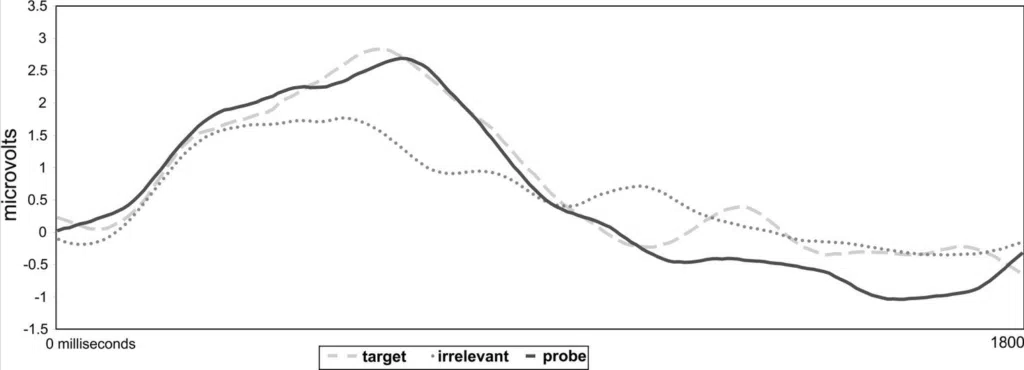Brain Fingerprinting
Brain fingerprinting is a lie detection technique based on EEG measurements. Strictly speaking, it is a guilty knowledge or concealed information test, which detects if a person is concealing information purely from EEG recordings. It does so by measuring the EEG response of a person to carefully selected visual stimuli.
During brain fingerprinting measurements a person under investigation is shown 3 types of visual stimuli, that can be photos, images, short text:
- Irrelevants. This type of stimuli are not related to the subject matter. For example, in a crime investigation, that could be various photos of guns or other objects that are unrelated to this particular crime.
- Targets. This type of stimuli are related to the subject matter. So in the case of a crime investigation example, that could be various objects from the crime scene that would be known to the whole public.
- Probe. As the name suggests this would be the stimulus that the brain fingerprinting would check if a person knows about. In our example, that could be some detail from the crime scene that only the offender could know.
The EEG response to these types of stimuli is measured, namely the P300 potential. It is an event-related potential that could be elicited by various stimuli, for example, by an unexpected stimulus in a sequence of stimuli. It can also be used in BCI for selecting a desired option (link). In brain fingerprinting, the generated P300 potential is checked against target and irrelevant stimuli. If the probe response is closer to the irrelevant, it indicates that the person has no knowledge about the things shown in the probe stimulus. However, if the probe response is closer to the target, the person is likely concealing information and has seen things shown in the probe stimulus. As the P300 potential peaks at around 300 ms after the image is presented, it is an ‘automated’ response by the person and therefore it is practically impossible to control/fake it.
An example of the P300 response to the 3 different types of stimuli is shown in Figure 1. In this particular case, it is clear that a person is concealing information as the probe generated a very similar response to the target, particularly around P300 potential peak.

Figure 1. Taken from [1]. “Information present” brain response of a serial killer. Brain response of serial killer J. B. Grinder to information relevant to the murder of Julie Helton. There is a clear P300-MERMER in response to the known targets. The P300 is the positive voltage peak at the upper left. The P300-MERMER contains both the P300 peak and the late negative potential (LNP) at the lower right. There is no P300-MERMER in response to the irrelevants. Grinder’s brain response to the crime-relevant probes clearly contains a P300-MERMER. This shows that the record in the brain of J. B. Grinder contains salient details of the murder. Determination: “information present.” Statistical confidence: 99.9%
So far only visual stimuli have been mentioned, however, brain fingerprinting technique in general could be extended to audio stimuli as well. Event-related potentials to auditory stimuli could then be used to evaluate the response instead of P300 potential.
Brain fingerprinting is a promising technique for lie detection, but it hasn’t been widely adopted yet. While in theory it could be very accurate, the EEG signals are very complex and the results depend a lot on the hardware used, preprocessing and analysis techniques employed. The careful selection of stimuli representing the aforementioned three classes is also essential for non-ambiguous results. Moreover, a person under investigation can also sabotage the measurements by not focusing and paying attention to the stimuli or by trying to visualize something else altogether.
Although brain fingerprinting has been used in investigations, the test results themselves can not yet be admitted as evidence in a legal trial. Nonetheless, as the technology evolves, brain fingerprinting may become a standard tool in crime investigations and other applications.
References
[1] L. A. Farwell et. al. “Brain fingerprinting: a comprehensive tutorial review of detection of concealed information with event-related brain potentials”, 2012.
[2] E. H. Meijer et. al. “A comment on Farwell (2012): brain fingerprinting: a comprehensive tutorial review of detection of concealed information with event-related brain potentials”, 2012.
[3] L. A. Farwell et. al. “Brain fingerprinting field study on major, terrorist crimes supports the brain fingerprinting scientific standards hypothesis: classification concealed information test with P300 and P300-MERMER succeeds; comparison CIT fails”, 2022.
